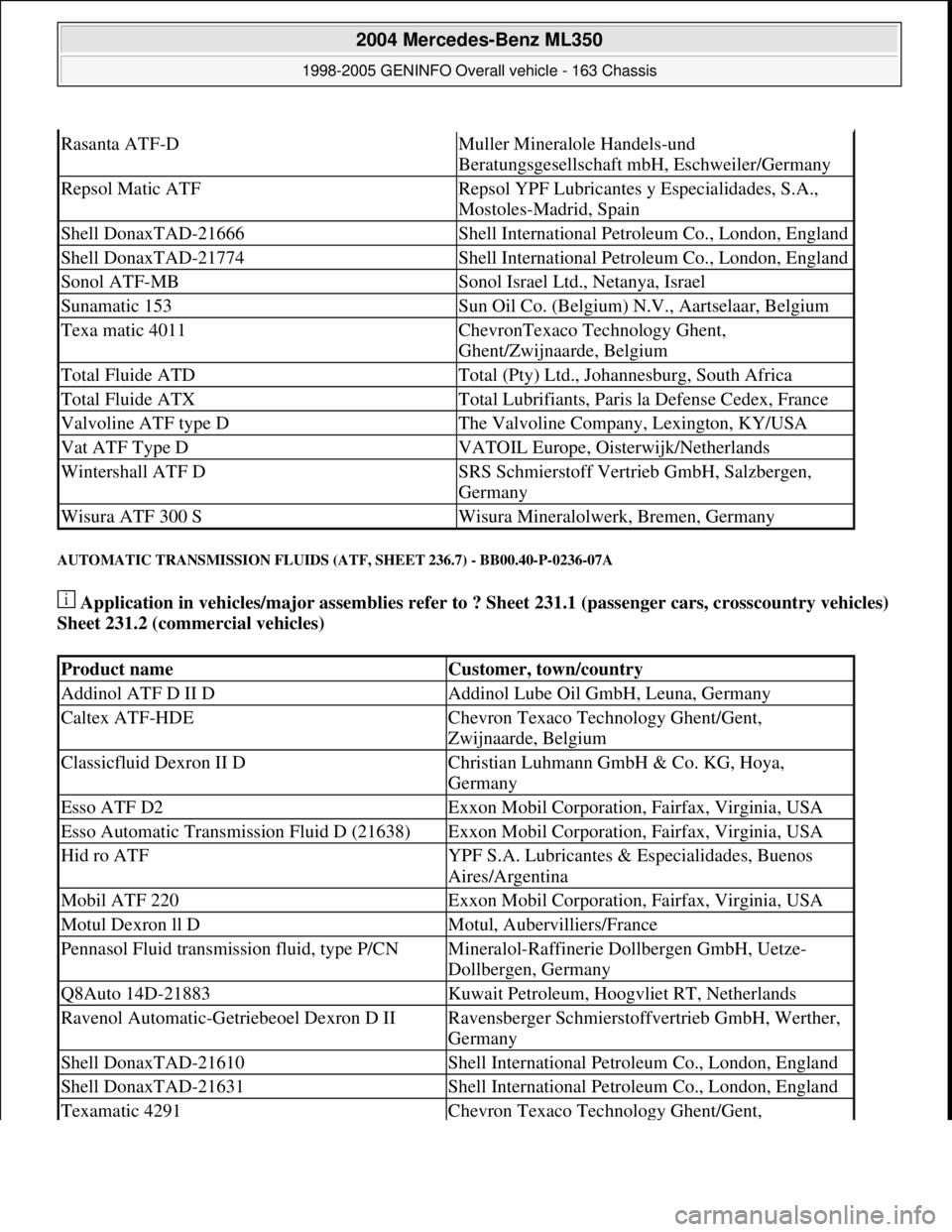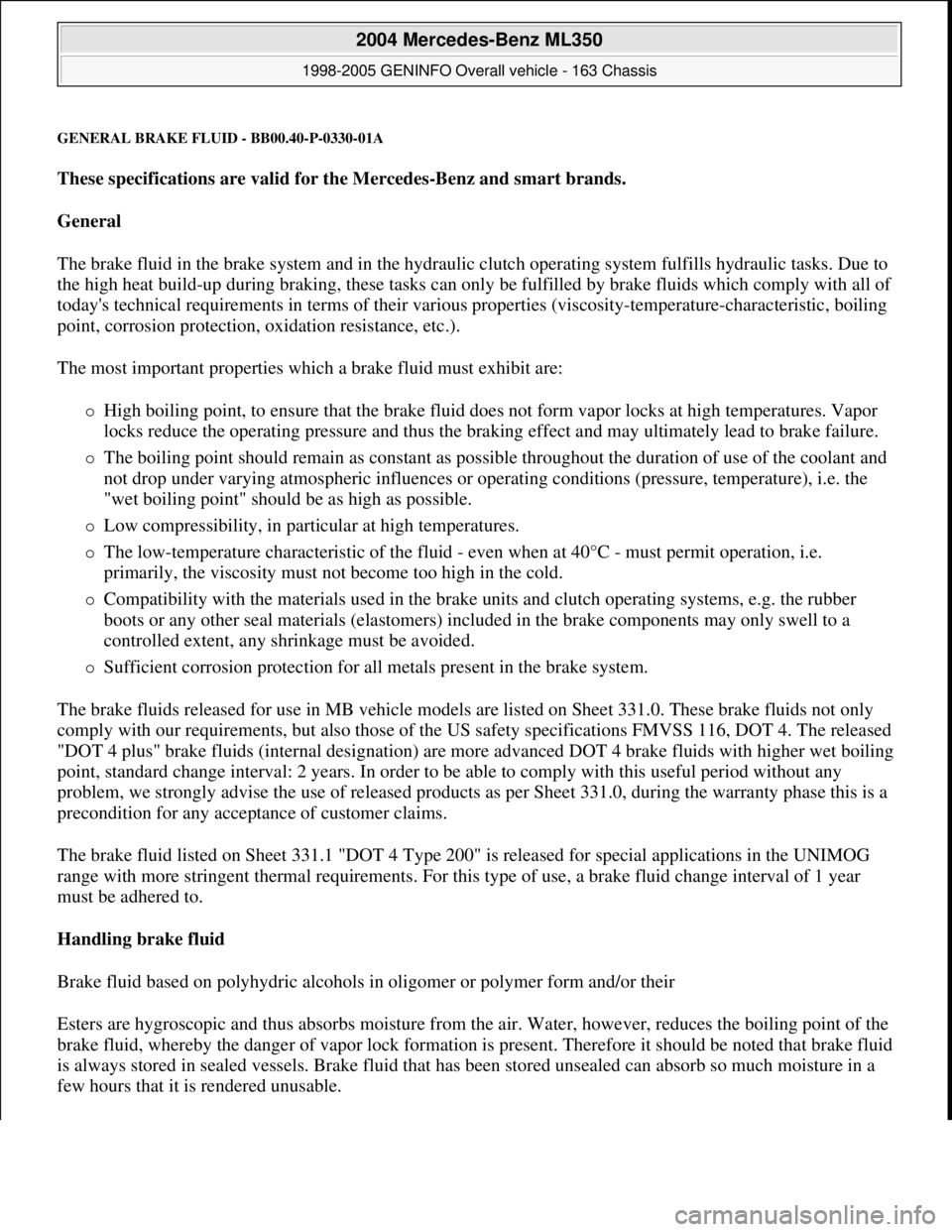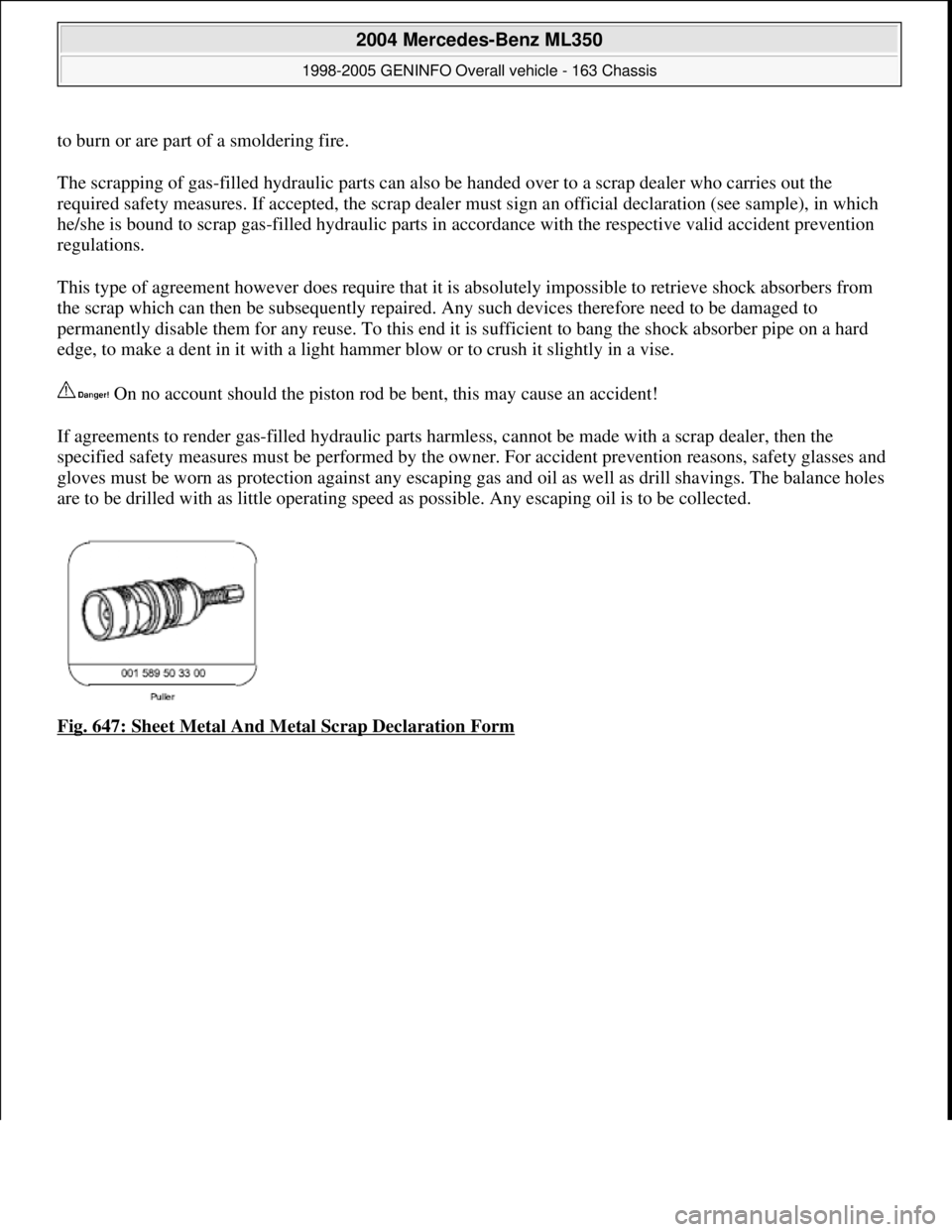1997 MERCEDES-BENZ ML430 oil type
[x] Cancel search: oil typePage 2883 of 4133
![MERCEDES-BENZ ML430 1997 Complete Repair Manual MODELS 124, 129, 140, 163 up to 30.11.99, 163 as of 1.9.01, 168, 170, 201, 202, 208, 210, 215, 220
EXPLANATION OF SYMBOLS FOR TESTERS AND COMPONENTS - AD00.00-P-2000-01A
0.0 [] 1Key to diagnostics
s MERCEDES-BENZ ML430 1997 Complete Repair Manual MODELS 124, 129, 140, 163 up to 30.11.99, 163 as of 1.9.01, 168, 170, 201, 202, 208, 210, 215, 220
EXPLANATION OF SYMBOLS FOR TESTERS AND COMPONENTS - AD00.00-P-2000-01A
0.0 [] 1Key to diagnostics
s](/manual-img/4/57307/w960_57307-2882.png)
MODELS 124, 129, 140, 163 up to 30.11.99, 163 as of 1.9.01, 168, 170, 201, 202, 208, 210, 215, 220
EXPLANATION OF SYMBOLS FOR TESTERS AND COMPONENTS - AD00.00-P-2000-01A
0.0 [] 1Key to diagnostics
symbols AD00.00-P-2001A
0.0 [] 2Diagnosis assignmentexcept models 215, 220AD00.00-P-2002A
0.0 [] 3Connect test equipment
diagnosisexcept model 215AD00.00-P-2003A
0.0 [] 4Diagnostic procedureonly for vehicle systems
that can be diagnosed using
STAR DIAGNOSISAD00.00-P-2004A
DescriptionLogoDescriptionLogoDescriptionLogo
ABS Adapter Battery Short-circuit
35-pin socket
box Direct current
generator Short-circuit to
ground
126-pin socket
box Direct current
motor Open-circuit
Function
generator Capacitor Multimeter
alternating
voltage type of
measurement
Hand-Held
Tester Coil Multimeter
resistance type of
measurement
Pulse counter Resistance Function
generator square-
wave signal shape
Lambda control
tester Ground Function
generator
sinusoidal signal
shape
Pressure gauge In order Oscilloscope
Multimeter Fault Adapter cable
with light-
emitting diode
Decade resistor Greater than > Multimeter direct
current type of
measurement
Bridge Less than < Multimeter
alternating
current type of
measurement
2004 Mercedes-Benz ML350
1998-2005 GENINFO Overall vehicle - 163 Chassis
me
Saturday, October 02, 2010 3:47:48 PMPage 238 © 2006 Mitchell Repair Information Company, LLC.
Page 3146 of 4133

1. Hypoid gear oils
Hypoid gear oils contain a high level of EP/AW additives (Extreme Pressure/Antiwear) and a highly
viscous base oil to prevent seizure when the hypoid gears mesh (mixed and boundary friction conditions)
and to ensure a high degree of protection against wear. The compatibility with radial shaft seals is
regarded as critical with such high concentrations of additives because the P/S additive systems become
thermally unstable at temperatures from 130°C to 140°C and this may lead to sludging of the hypoid oil.
The resultant deposits on the radial shaft seals then generally lead to thermal overload and this in turn
leads to leakage in this component.
The tooth engagement conditions of the hypoid gears result in a high proportion of sliding and a low
hydrodynamic proportion of tooth engagement between the pinion and ring gear. Due to the high
tribological load compared to adhesive wear (seizure) and pitting, the performance of hypoid gear oils
must be particularly high with respect to these types of wear. The formula of the oils is therefore
determined by a high concentration of EP/AW additives and a highly viscous base oil. Alternative oils,
e.g. engine oils, cannot be used for these drive types. Proof of performance that an oil fulfills the
requirements of DaimlerChrysler AG is provided by internal tests. However, the hypoid gear oils must at
least correspond to the US military specification MIL-L-2105 B/C/D and must be classed GL-5 in the
quality grade according to API (American Institute of Petroleum).
1.7 Viscosity requirements
The cold flow behavior is only specified for SAE, ... oils. Here, the limits apply according to SAE J 306
c, according to which the dynamic viscosity may be max. 150,000 mPas at -40°C for oils and at -12°C for
oils. As a result of the tendency to form deposits in the transmission, the polymer content is limited to
max.
1 percent by weight for pour point reducers. Polymers as VI improvers for thickening low-viscosity base
oils are not permitted. The kinematic viscosity at 100°C must be at least 16.5 mm
2 /s.
2. Transmission oils, sheet 235.1
The additive and viscosity properties of the transmission oils are adjusted so that they meet all the
requirements placed on manual transmissions with steel/molybdenum synchronization, spur gear axles,
MB and ZF transfer cases and reversing gears. Among other things, this results in the fact that the oils
ensure a defined friction coefficient of the synchronizer elements, even after a high number of shift
operations, without crunching noises.
With gear drives and roller bearings, the adhesive wear (seizure) and pitting in particular should be
minimized as far as possible.
2.1 Viscosity requirements
The cold flow behavior is only specified for SAE, 80W, ...oils. Here, the limits according to SAE J 306 c
apply, according to which the dynamic viscosity may be max. 150,000 mPas at -40°C for oils, at -26°C
for oils and at -12°C for oils. Due to the formation of deposits in the transmission, the polymer content is
limited to max. 1 percent b
y weight for pour point reducers. Polymers as VI improvers for thickening
2004 Mercedes-Benz ML350
1998-2005 GENINFO Overall vehicle - 163 Chassis
me
Saturday, October 02, 2010 3:47:56 PMPage 501 © 2006 Mitchell Repair Information Company, LLC.
Page 3149 of 4133

W4B035.
3.2 Automatic transmission fluids (ATF), sheet 236.2 , for MB passenger car and commercial vehicle
transmissions with non-ferrous metal synchronization except front-wheel drive manual transmissions of
the A-Class (see Section 2.5, Sheet 235.10), Allison transmission, commercial vehicle power steering,
hydraulic fan drive.
The ATF must meet all the requirements of the transmissions with nonferrous metal synchronization.
These include, in particular, wear protection against pitting and seizure as well as a defined friction
coefficient of the synchronizer components that is as constant as possible over the entire service life. As a
hydraulic fluid, the ATF is used for hydraulic power transmission and for protecting the hydraulic
assemblies from wear. The seal compatibility must be ensured with all elastomer materials used.
If the approved ATF are not available, engine oils according to sheet 227.0, SAE 10W or, depending on
the outside temperature, 20W-20 can be used in the above-mentioned synchronized manual transmissions
as a makeshift measure (queries should be directed to the Abt. Betriebstoffe EP/QWB (EP/QWB
Operating Fluids Dept.).
The approved ATF according to Sheet 236.2 correspond to the currently no longer valid GM specification
Type A Suffix A. The kinematic fresh oil viscosity at 100°C must be at least 7.0 mm
2 /s, after shearing
(as per CEC- TLPG 7) at least 6.0 mm
2 s.
3.3 Steering gear oil, sheet 236.3 , for all commercial vehicle steering systems, except vans T0 and T1N,
power steering systems for passenger cars, except
S-Class W220, power pack of the A-Class, and cross-country vehicles, manual steering L 075 Z for
passenger cars and manual steering in cross-country vehicle.
In the S class W220, in the Power-Pack of the A class as well as in the Transporters T0 and T1N as
of/below outside temperatures of 25°C the hydraulic fluids according to sheet 345.0 must be used.
3.4 Automatic transmission fluids (ATF) and/or engine oils, sheet 236.5 , for Allison transmission HAT
700
The oils listed here correspond to the Allison-C4 specification. Allison automatic transmissions in makes
AT 500, MT 600, S1000, S2000, World Transmission MD 3000, HD 4000 must only be filled with the
oils specified in Sheet 236.9 or TES 295.
If prior to starting the vehicle the gear oil temperature is below the critical temperature for the oil used,
then either the gear oil should be prewarmed or the transmission should be warmed up while in neutral.
Automatic transmissions in the model series CLBT 750 must only ever be filled with oils according to
Sheet 236.5. Under extreme operating conditions or for off-road use and/or with outside temperatures
higher than 30°C an engine oil of SAE grade 30 and/or 15W-40 from Sheet 236.5 should be used.
Depending on the outside temperature during vehicle operation, the oils used must be selected from the
followin
g diagram according to their SAE viscosity class and/or Dexron specification:
2004 Mercedes-Benz ML350
1998-2005 GENINFO Overall vehicle - 163 Chassis
me
Saturday, October 02, 2010 3:47:56 PMPage 504 © 2006 Mitchell Repair Information Company, LLC.
Page 3161 of 4133

AUTOMATIC TRANSMISSION FLUIDS (ATF, SHEET 236.7) - BB00.40-P-0236-07A
Application in vehicles/major assemblies refer to ? Sheet 231.1 (passenger cars, crosscountry vehicles)
Sheet 231.2 (commercial vehicles)
Rasanta ATF-DMuller Mineralole Handels-und
Beratungsgesellschaft mbH, Eschweiler/Germany
Repsol Matic ATFRepsol YPF Lubricantes y Especialidades, S.A.,
Mostoles-Madrid, Spain
Shell DonaxTAD-21666Shell International Petroleum Co., London, England
Shell DonaxTAD-21774Shell International Petroleum Co., London, England
Sonol ATF-MBSonol Israel Ltd., Netanya, Israel
Sunamatic 153Sun Oil Co. (Belgium) N.V., Aartselaar, Belgium
Texa matic 4011ChevronTexaco Technology Ghent,
Ghent/Zwijnaarde, Belgium
Total Fluide ATDTotal (Pty) Ltd., Johannesburg, South Africa
Total Fluide ATXTotal Lubrifiants, Paris la Defense Cedex, France
Valvoline ATF type DThe Valvoline Company, Lexington, KY/USA
Vat ATF Type DVATOIL Europe, Oisterwijk/Netherlands
Wintershall ATF DSRS Schmierstoff Vertrieb GmbH, Salzbergen,
Germany
Wisura ATF 300 SWisura Mineralolwerk, Bremen, Germany
Product nameCustomer, town/country
Addinol ATF D II DAddinol Lube Oil GmbH, Leuna, Germany
Caltex ATF-HDEChevron Texaco Technology Ghent/Gent,
Zwijnaarde, Belgium
Classicfluid Dexron II DChristian Luhmann GmbH & Co. KG, Hoya,
Germany
Esso ATF D2Exxon Mobil Corporation, Fairfax, Virginia, USA
Esso Automatic Transmission Fluid D (21638)Exxon Mobil Corporation, Fairfax, Virginia, USA
Hid ro ATFYPF S.A. Lubricantes & Especialidades, Buenos
Aires/Argentina
Mobil ATF 220Exxon Mobil Corporation, Fairfax, Virginia, USA
Motul Dexron ll DMotul, Aubervilliers/France
Pennasol Fluid transmission fluid, type P/CNMineralol-Raffinerie Dollbergen GmbH, Uetze-
Dollbergen, Germany
Q8Auto 14D-21883Kuwait Petroleum, Hoogvliet RT, Netherlands
Ravenol Automatic-Getriebeoel Dexron D IIRavensberger Schmierstoffvertrieb GmbH, Werther,
Germany
Shell DonaxTAD-21610Shell International Petroleum Co., London, England
Shell DonaxTAD-21631Shell International Petroleum Co., London, England
Texamatic 4291Chevron Texaco Technology Ghent/Gent,
2004 Mercedes-Benz ML350
1998-2005 GENINFO Overall vehicle - 163 Chassis
me
Saturday, October 02, 2010 3:47:56 PMPage 516 © 2006 Mitchell Repair Information Company, LLC.
Page 3175 of 4133

GENERAL BRAKE FLUID - BB00.40-P-0330-01A
These specifications are valid for the Mercedes-Benz and smart brands.
General
The brake fluid in the brake system and in the hydraulic clutch operating system fulfills hydraulic tasks. Due to
the high heat build-up during braking, these tasks can only be fulfilled by brake fluids which comply with all of
today's technical requirements in terms of their various properties (viscosity-temperature-characteristic, boiling
point, corrosion protection, oxidation resistance, etc.).
The most important properties which a brake fluid must exhibit are:
High boiling point, to ensure that the brake fluid does not form vapor locks at high temperatures. Vapor
locks reduce the operating pressure and thus the braking effect and may ultimately lead to brake failure.
The boiling point should remain as constant as possible throughout the duration of use of the coolant and
not drop under varying atmospheric influences or operating conditions (pressure, temperature), i.e. the
"wet boiling point" should be as high as possible.
Low compressibility, in particular at high temperatures.
The low-temperature characteristic of the fluid - even when at 40°C - must permit operation, i.e.
primarily, the viscosity must not become too high in the cold.
Compatibility with the materials used in the brake units and clutch operating systems, e.g. the rubber
boots or any other seal materials (elastomers) included in the brake components may only swell to a
controlled extent, any shrinkage must be avoided.
Sufficient corrosion protection for all metals present in the brake system.
The brake fluids released for use in MB vehicle models are listed on Sheet 331.0. These brake fluids not only
comply with our requirements, but also those of the US safety specifications FMVSS 116, DOT 4. The released
"DOT 4 plus" brake fluids (internal designation) are more advanced DOT 4 brake fluids with higher wet boiling
point, standard change interval: 2 years. In order to be able to comply with this useful period without any
problem, we strongly advise the use of released products as per Sheet 331.0, during the warranty phase this is a
precondition for any acceptance of customer claims.
The brake fluid listed on Sheet 331.1 "DOT 4 Type 200" is released for special applications in the UNIMOG
range with more stringent thermal requirements. For this type of use, a brake fluid change interval of 1 year
must be adhered to.
Handling brake fluid
Brake fluid based on polyhydric alcohols in oligomer or polymer form and/or their
Esters are hygroscopic and thus absorbs moisture from the air. Water, however, reduces the boiling point of the
brake fluid, whereby the danger of vapor lock formation is present. Therefore it should be noted that brake fluid
is always stored in sealed vessels. Brake fluid that has been stored unsealed can absorb so much moisture in a
few hours that it is rendered unusable.
2004 Mercedes-Benz ML350
1998-2005 GENINFO Overall vehicle - 163 Chassis
me
Saturday, October 02, 2010 3:47:57 PMPage 530 © 2006 Mitchell Repair Information Company, LLC.
Page 3177 of 4133

to burn or are part of a smoldering fire.
The scrapping of gas-filled hydraulic parts can also be handed over to a scrap dealer who carries out the
required safety measures. If accepted, the scrap dealer must sign an official declaration (see sample), in which
he/she is bound to scrap gas-filled hydraulic parts in accordance with the respective valid accident prevention
regulations.
This type of agreement however does require that it is absolutely impossible to retrieve shock absorbers from
the scrap which can then be subsequently repaired. Any such devices therefore need to be damaged to
permanently disable them for any reuse. To this end it is sufficient to bang the shock absorber pipe on a hard
edge, to make a dent in it with a light hammer blow or to crush it slightly in a vise.
On no account should the piston rod be bent, this may cause an accident!
If agreements to render gas-filled hydraulic parts harmless, cannot be made with a scrap dealer, then the
specified safety measures must be performed by the owner. For accident prevention reasons, safety glasses and
gloves must be worn as protection against any escaping gas and oil as well as drill shavings. The balance holes
are to be drilled with as little operating speed as possible. Any escaping oil is to be collected.
Fig. 647: Sheet Metal And Metal Scrap Declaration Form
2004 Mercedes-Benz ML350
1998-2005 GENINFO Overall vehicle - 163 Chassis
me
Saturday, October 02, 2010 3:47:57 PMPage 532 © 2006 Mitchell Repair Information Company, LLC.
Page 3190 of 4133

AF18.00-P-8044D
High oil consumption
12.3.01
ENGINE
112 in MODEL 129, 163, 170, 202, 203, 208, 210, 220
ENGINE
113 in MODEL 129, 163, 202, 208, 210, 215, 220
ENGINE
112, 113 in MODEL 463
Damage code
Cause
Remedy
Studies on engines 112/113 due to
excessive engine oil consumption have
indicated to date that excessive engine oil
consumption is not a general subject, but
rather can result from various causes.
The causes listed below may cause
excessive engine oil consumption individually
or in combination.
For commercially available tools for see
Workshop Equipment Manual
Cause 1:
Remedy 1:
00 001 70
Cast iron crust in right cylinder head behind
oil drain opening
1
Remove cast iron crust
AF18.00-P-8045A
Cause 2:
Remedy 2:
00 001 70
V-shaped material flaws (rough unhoned
points) on individual cylinder liners
Up to production 08/2000.
1
Check cylinder liners with piston at
bottom dead center.
#
Inspect cylinders with light probe
AR01.00-P-0200AU
*WH58.30-Z-1009-05A
*WH58.30-Z-1010-05A
*WH58.30-Z-1027-05A
Cylinder barrels not okay:
#
2
Remove/install/replace engine or
shortblock.
Cause 3:
Remedy 3:
00 001 70
Single oil scraper rings with ring tension at
lower tolerance limit.
Up to production 06/1999.
1
Perform oil consumption test drive over
approx. 500 km.
AR18.00-P-0025AV
Exclude all other types of faults.
2
Remove/install/replace piston rings.
Install cleaned pistons with new piston
rings in the same cylinder.
Install piston rings with optimized ring
tension.
These piston rings are available as
replacement parts under the normal
replacement part number.
Cause 4:
Remedy 4:
00 001 70
Individual (right) cylinder heads with inner
porous points to air injection duct.
1
Check left/right cylinder bank.
If a cylinder bank is oily:
#
2
Remove/install/replace only this cylinder
head.
ENGINE
112 in MODEL 220, 210, 208, 202,
129
ENGINE
113 in MODEL 220, 210, 208, 202,
129
AR01.30-P-5800B
ENGINE
112.942 in MODEL 163.154
ENGINE
113.942 in MODEL 163.172
ENGINE
113.981 in MODEL 163.174 AR01.30-P-5800MV
ENGINE
112.945, 113.962 in MODEL 463
AR01.30-P-5800GV
Cause 5:
Remedy 5:
00 001 70
Individual engines with missing valve seals on
individual cylinders
1
Remove valve springs on affected
cylinder.
AR05.30-P-3500B
In this case, usually one cylinder is oily, oil
runs through valve cone into cylinder when
valve is open.
2
Check valve seal.
Copyright DaimlerChrysler AG 20.05.2006 CD-Ausgabe G/10/04 . This WIS print-out will not be recorde
d by Modification services.
Page 1
Page 3191 of 4133

Valve seal not okay :
#
3
Remove/install/replace valve seal.
AR05.30-P-3500B
Cause 6:
Remedy 6:
00 001 70
1.5 mm hole missing on individual right
cylinder head covers at connection to
crankcase ventilation.
1
Check cylinder head cover
Up to production 06/1999.
Crankcase ventilation out of order, engine can
sludge up and consume oil as a result
Cylinder head cover not okay:
#
2
Remove/install/replace cylinder head
cover.
ENGINE
112
Air cleaner positioned on engine
side.
ENGINE
113
Air cleaner positioned on engine
side.
AR01.20-P-5014BV
ENGINE
112
Air cleaner positioned on engine side
ENGINE
113
Air cleaner positioned on engine side
AR01.20-P-5014B
Cause 7:
Remedy 7:
00 001 70
Engine oil sludging due to excessively long
engine oil change intervals
Service information: Oil sludge
SI18.00-P-0010A
If the service interval according to
ASSYST is exceeded, the engine oil sludges
up sooner or later depending on the oil
quality, type of operation and operating time.
Engine consumes oil.
See Service Information.
1
Print out ASSYST printout.
2
Check oil change intervals
3
Inform vehicle owner.
4
Remove/install/replace piston rings.
AR03.10-P-7311BV
Disassemble and clean sludged engines
completely because dirty oil usually gets into
clean-oil side due to clogged oil filter.
Cause 8:
Remedy 8:
00 001 70
Piston rings sticky or have coke deposits from
engine oils (e.g. API-S in USA) in connection
with regionally poor fuel quality.
Always use engine oils according to
Specifications for Operating Fluids 229.3, do
not add special additives to engine oil and fuel
BB00.40-P-0229-03A
1
Remove/install/replace piston rings.
AR03.10-P-7311BV
Cause 9:
Remedy 9:
00 001 70
Piston ring wear due to excessive
contamination/dust (model 163) through air
intake system.
1
Remove/install/replace gaskets on air
intake line and distribution element of
partial load ventilation.
e.g. due to incorrect assembly after
workshop visit or embrittlement of gaskets
The distribution element with optimized
material will be available as of 11/ 2000 as a
standard feature.
2
Remove/install/replace intake module.
Exterior oil loss, e.g. due to cast iron
porosity on left side of crankcase in area of
engine support is not considered to be oil
consumption
In the event of a customer complaint
regarding the engine oil consumption, always
determine the oil consumption definitely
because the oil indicator lamp can come on
due to other causes (e.g. defective oil sensor).
Commercially available tools
(see Workshop Equipment Manual)
Number
Designation
Make (e. g.)
Order number
WH58.30-Z-1009-05A
Flexible inspection light
Scope of supply 1 (complete unit):
-glass fiber optical fiber
-light projector
-230 V, storage case
-operating instructions
-graphics protocol
Richard Wolf GmbH
Pforzheimerstr. 32
D-75438 Knittlingen
Karl Storz GmbH
Mittelstr. 8
D-78532 Tuttlingen
1.00565.00
80902
WH58.30-Z-1010-05A
Flexible inspection light
Scope of delivery 2 (for workshops which already have an approved
Wolf or Storz inspection light):
-storage case
-operating instructions
-pictures protocol
Richard Wolf GmbH
Pforzheimerstr. 32
D-75438 Knittlingen
Karl Storz GmbH
Mittelstr. 8
D-78532 Tuttlingen
7.05065.00
K03506AJ
Copyright DaimlerChrysler AG 20.05.2006 CD-Ausgabe G/10/04 . This WIS print-out will not be recorde
d by Modification services.
Page 2